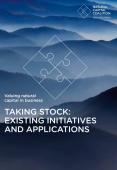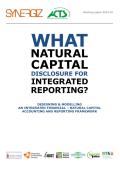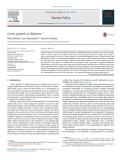
This publication is a takes stock of existing initiatives and applications relevant for valuing natural capital. A baseline of existing initiatives is provided in order to inform the Natural Capital Protocol project. It is also intended to be a useful resource to demystify the growing volume of natural capital relevant initiatives emerging from the private and public sectors. The following existing initiatives have been reviewed and are summarised:
- Business engagement initiatives.
- Methodologies, tools and initiatives relevant to measuring, managing and valuing natural capital in business and investor decision making.
- Initiatives relevant to using natural capital valuation in business applications eg, strategy, management (at organisation or supply chain levels), reporting and disclosure.
- Policy initiatives that define natural capital accounting classifications, metrics and indicators that can inform future target setting and new market initiatives relevant to business.

Businesses and government leaders from around the world are increasingly sounding the alarm about the need for effective management of business dependencies and impacts on ecosystems. Though various frameworks and standards have been developed and implemented to improve extra-financial accountability to stakeholders, current sustainability reporting falls short in providing the information needed for accurate investment decision-making. The recent releases of Integrated Reporting (IR) guidelines have been presented as a significant step in the right direction by professionals and academics.
This report, part of a new series by IRENA, explores how renewable energy is financed, produced, distributed and consumed, and will chart the changing relationships it is bringing about between states, corporations and individuals.
This first volume focuses upon the power sector. It tells a story – about the trends driving this change, how the technology is evolving, who is financing it, and the wider benefits it will bring. Finally, it examines what an energy system powered by renewables might look like and how policy makers can further support the transformation.
Africa is well endowed with potential for hydro and solar power, but its other endowments – shortages of capital, skills, and governance capacity – make most of the green options relatively expensive, while its abundance of hydro-carbons makes fossil fuels relatively cheap. Current power shortages make expansion of power capacity a priority. Africa's endowments, and the consequent scarcities and relative prices, are not immutable and can be changed to bring opportunity costs in Africa closer to those in the rest of the world. The international community can support by increasing Africa's supply of the scarce factors of capital, skills, and governance.
This article appeared in the Energy Economics Supplemental Issue: Green Perspectives.
The concept of “green growth” can be fruitfully connected to concepts and theories in neoclassical economics including market externalities, Ricardian and Hotelling rents, and policies that would correct externalities such as Pigovian taxes or a cap and trade system set to achieve emissions reductions consistent with cost benefit assessment. Partial equilibrium concepts have been extended to general equilibrium models, including their realization in relatively detailed empirical models that faithfully adhere to theoretical concepts of neoclassical economics. With such models we are then able to see how resource depletion and environmental degradation are affecting the economy, and how efforts to reduce the impact of these environmental and resource constraints could improve economic growth and performance.
The 1992 Framework Convention on Climate Change created the basic international architecture for addressing climate change. That treaty was negotiated at a time when the research literature examining emissions mitigation and the role of energy technology was relatively limited. In the two subsequent decades a great deal has been learned. The problem of stabilizing the concentration of greenhouse gases in the atmosphere has proved far more difficult than envisioned in 1992 and the role of technology appears even more important when emissions mitigation strategies are co-developed in the context of multiple competing ends.
This article appeared in the Energy Economics Supplemental Issue: Green Perspectives.
Green growth was a key theme of 2012's Rio+20 conference. There is, however, confusion about what should be sustained: Is it all encompassing development? Is it economic growth, greened or otherwise? Or is it human well-being? This commentary compares these concepts within a framework of sustainability categories. The reality test of measurability points to green growth rather than all-inclusive wealth, welfare or holistic development.
This paper uses a Directional Distance Function (DDF) and the Malmquist–Luenberger Productivity Index to estimate the changing patterns of ‘green’ total factor productivity (GTFP) growth of 38 Chinese industrial sectors during the period 1980–2010. Unlike the measures of traditional total factor productivity (TFP) growth, the DDF incorporates carbon dioxide emissions as an undesirable output directly into the production technology, which credit sectors for simultaneously reducing their emissions and increasing their output. Our estimates of aggregate and sector-level GTFP growth reveal that Chinese industry is not yet on the path towards sustainable, low-carbon growth. A dynamic panel data analysis of the determinants of GTFP across sectors is used to identify factors that might rectify this situation, including state owned enterprise (SOE) reform, the growth of small private enterprises, continued openness to foreign investment and higher spending on R&D, particularly in emission-intensive sectors.

This analysis of the emergence since 2008 of the green economy agenda and the related idea of ‘green growth’ focusses upon the articulation of these discourses within key international economic and environmental institutions and evaluates whether this implies the beginning of an institutional transformation towards an ecologically sustainable world economy. The green economy may have the capacity to help animate a transition away from current socially and ecologically unsustainable patterns of economic growth only if notions of green growth can be discursively separated from green economy, strong articulations of green economy become dominant, and alternative measures of progress to gross domestic product are widely adopted. The concept of ‘rearticulation’, found in post-structural discourse theory, is proposed to guide this transition. This offers a framework to reconstruct notions of prosperity, progress, and security whilst avoiding direct and disempowering discursive conflict with currently hegemonic pro-growth discourses.
